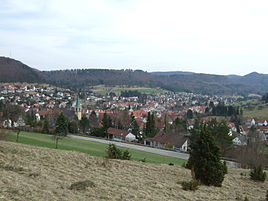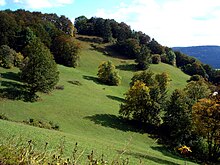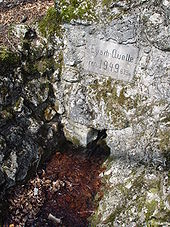Pfeffingen (Albstadt)
|
Pfeffingen
City of Albstadt
|
|
|---|---|
| Coordinates: 48 ° 15 ′ 15 ″ N , 8 ° 57 ′ 50 ″ E | |
| Height : | 743 m |
| Area : | 13.43 km² |
| Residents : | 1993 (Jun 30, 2020) |
| Population density : | 148 inhabitants / km² |
| Incorporation : | 1st January 1975 |
| Postal code : | 72459 |
| Area code : | 07432 |
|
Location map of Pfeffingen in the city of Albstadt
|
|
|
Panorama of Pfeffingen
|
|
Pfeffingen is a district of Albstadt in the Zollernalbkreis in Baden-Württemberg . It is located on the Swabian Alb , about halfway between Stuttgart and Lake Constance . To the east is Tailfingen , to the south is Margrethausen and to the west is Burgfelden .
geography
Geographical location
Pfeffingen lies at an altitude of 764 m, embedded in several small side valleys at the origin of the Eyach in the Swabian Alb . Intensive sheep breeding is still practiced today, characteristic of the Swabian Alb and it is not uncommon to find large flocks of sheep around Pfeffingen. The landscape is preserved by numerous nature reserves and cared for by mostly voluntary helpers, such as the Irrenberg-Hundsücken nature reserve north of Pfeffingen.
geology
Pfeffingen is located in the Eyachtal between the Heersberg , the Hornau and the Auchtberg . The ammonite-rich Pfeffinger area of the Swabian Alb was proposed as Global Stratotype Section and Point (GSSP) for the Callovian ( Middle Jurassic ) because of its complete and continuous succession of ammonite zones and sub-zones from Upper Bathonian and Lower Callovian. Biostratigraphic characteristics are the first appearance of the genus Kepplerites (ammonite).
District
Pfeffingen has an area of 1343 hectares. There are also spatially separate dwellings with their own name, which, however, usually have only a few inhabitants, or residential areas with their own name, the names of which have emerged in the course of the development and whose boundaries are usually not precisely defined. These include the Brechetsteighof, Roschbach and the Zitterhof in Pfeffingen.
history
Early history
Conclusions from finds from the earlier Iron Age suggest that this area was first settled around 700 BC. Have taken place. 790 Pfeffingen belonged to the Scherragrafschaft . The place was mentioned for the first time in a document from the St. Gallen monastery in 793 as Faffinga , when Count Berthold donated the Pfeffingen property to the monastery. The monastery of St. Gallen received interest from the community until 1320. The place itself is an Alemannic foundation, as are all dwellings that end in -ingen . The first part of the place name usually indicates the leader or founder of the settlement. Pfeffingen means: belonging to the people of Paffo or Faffo .
middle Ages
On November 3, 1403 Pfeffingen came to Württemberg and was assigned to the office in Balingen . In 1525 Pfeffinger and Dürrwanger farmers took part in the Peasants' War in the siege of the neighboring Schalksburg . The Schalksburg was looted and the town of Balingen came under the control of the farmers of Pfeffingen. Duke Ulrich von Württemberg carried out the Reformation in his territory (and thus also in Pfeffingen) in 1534 ; since then Pfeffingen has been Protestant.
industrialization
In the 18th century more and more coal was burned and pine chips were extracted from fir roots. The busy trade in the resin-rich pine chips brought the Pfeffingers the name Kea-Land , which is still known today for the Pfeffingers and the surrounding communities. That's why there is a statue in the center of the village, the Keaweib , a woman who carries the pine shavings in a basket to the market in Ebingen. The statue was donated by the community of Pfäffingen on the occasion of the 1200th anniversary of the village. From 1806, the place subordinated to the Oberamt Balingen belonged to the newly established Kingdom of Württemberg . In 1816, the year without a summer , the Tambora volcanic eruption of Sumbawa in April 1815 resulted in a total crop failure in Pfeffingen, with two thirds of the livestock dying. Great social hardship and high prices were triggered and numerous families emigrated abroad in the "year without a summer". The coldest summer ever recorded in Europe brings the municipality of Pfeffingen, which has been weakened by the French wars, a catastrophic crop failure. The little in the fields is destroyed by the early onset of winter and people bake bread from bran and tree bark , they ate grass and nettles and a high mortality rate has been recorded.
In 1854 Christian August Ammann laid the foundation stone for the construction of the Zitterhof. The Pfeffingen football club was founded in 1919.
First and Second World War
During the First World War, the Pfeffingen community lost 28 dead and five missing. Pfeffingen came to the district in 1934 and to the district of Balingen in 1938 . In 1943 Pfeffingen was hit by a severe earthquake. Around 100 chimneys and numerous walls collapsed and the church tower was badly damaged. In the Second World War, the community of Pfeffingen complained about 68 dead and 38 missing. After the war ended, Pfeffingen was occupied by French troops.
post war period
In 1946/47 a ski jump for long ski jumping was built on the Pfeffinger ski slope. In 1950 the earthquake damage from 1943 was repaired. The church tower was dismantled and rebuilt.
Incorporations
On July 1, 1971, Burgfelden was incorporated into Pfeffingen. On January 1, 1975, Pfeffingen (with the district Burgfelden) became part of the newly formed large district town of Albstadt as part of the community reform .
Population development
| year | Residents without Burgfelden |
Residents with Burgfelden |
|---|---|---|
| November 3, 1403 | 506 | |
| 1648 | 153 | |
| 1854 | 998 | |
| 1871 | 1000 | |
| 1961 | 1436 | 1666 |
| 1970 | 1623 | 1837 |
| 1971 | 1343 | 1616 |
religion
- Evangelical parish
- Methodist Church Congregation
- New Apostolic Church Community
politics
mayor
Mayor
- 1975–1999: Gerhard Hils
- 1999–2009: Maria Elisabeth Keppler
- since 2009: Roland Merz
Twin cities
- Hendschiken ( Switzerland ): community partnership
coat of arms
The blazon of the coat of arms of Pfeffingen shows under a golden shield head, a lying black stag pole with a right-pointing root, in black two diagonally crossed golden spindles.
The colors and the stag stick indicate that Pfeffingen belongs to the House of Württemberg . The spindles symbolize the local textile industry. The coat of arms was awarded to the municipality on November 27, 1949.
Culture and sights
Museums
- Wagnerhausmuseum
Buildings
- The old church of St. Nicholas. The Nikolauskapelle has been mentioned since the 14th century. It was initially a branch of Burgfelden. After the Reformation it became the seat of the parish, while Burgfelden became a branch. Other places in the parish of Pfeffingen were Zillhausen and Streichen. The old church was replaced by a new building in 1897/98.
In Pfeffingen there are several very well-preserved half-timbered buildings that are several hundred years old.
- Vogtshaus
- Old mill towards Margrethausen
- The (today's) fire station
- White lead mill: In 1836 a white lead mill was established in the village . The lead white mill is the oldest factory building in the Albstadt area. However, this did not result in a large-scale industry.
- The Wagner house
Natural monuments
- The source of the Eyach , which rises on the outskirts of Pfeffingen
Sports
- FC 1919 Pfeffingen and currently plays in the district league A (2018/19).
- For winter sports enthusiasts, Pfeffingen has a ski lift with a length of 300 meters.
Regular events
- May 1st celebration with maypole decorations
- Annual fire brigade festival and open day with historical fire fighting exercises
- In cycling, women's stage races (racing bikes) take place in Pfeffingen every year in mid-August, starting on the first day with a demanding circuit and the next day with an individual time trial on the Irrenberg.
Economy and Infrastructure
traffic
The state road 442 traverses Pfeffingen in a west-easterly direction and is connected via the district roads K 7151 from the south to the federal road 463 and to the K 7141 from the north to Onstmettingen and via the stitch to the federal road 27 . Pfeffingen can also be reached with its own bus company with several bus stops.
Public facilities
- The Albstadt volunteer fire brigade , Pfeffingen department, has provided fire protection and general assistance since it was founded in 1855. It has an emergency department and its youth fire department .
- The DRK local association Pfeffingen leads an on-site volunteer task force and a youth Red Cross group. His area of activity extends to the towns of Pfeffingen, Burgfelden and Margrethausen, which belong to the city of Albstadt, and to the towns of Zillhausen and Streichen, which belong to the city of Balingen.
- The DRK rescue dog squadron Zollernalb was founded in 2007 and is used in particular to search for missing people.
Evangelical St. Nicholas Church
Methodist Church of St. Paul
education
- Kindergarten An der Eyach , Protestant kindergarten
- Pfeffingen primary school
Honorary citizen
- Pastor Hauber
- Friedrich Wißmann, Rector
literature
- Heinz Bader: At the origin of the Eyach. Alt-Pfeffingen . Geiger-Verlag, Horb am Neckar 1992, ISBN 3-89264-722-4 .
- Friedrich Wissmann: At the Eyach spring. A home book of Pfeffingen and Burgfelden . Pfeffingen 1959.
Web links
- District information on the website of the city of Albstadt
Individual evidence
- ↑ Elke Beher, Erich Brand & Matthias Franz: "Bathonian and Lower Callovian ostracods of Albstadt-Pfeffingen (Middle Jurassic, Baden-Wuerttemberg, Germany)." Palaeodiversity 3: 43-57; Stuttgart 30 December 2010, p. 43 ( online )
- ↑ GSSP Table - All Periods - International Commission on Stratigraphy (accessed September 1, 2017)
- ^ Federal Statistical Office (ed.): Historical municipality directory for the Federal Republic of Germany. Name, border and key number changes in municipalities, counties and administrative districts from May 27, 1970 to December 31, 1982 . W. Kohlhammer, Stuttgart / Mainz 1983, ISBN 3-17-003263-1 , p. 524 and 540 .
- ↑ Federal Statistical Office: Landkreis Balingen, Die Stadt- und Landkreise Baden-Württemberg in words and numbers Issue 63 , page 29 (pdf)
















